|
The confluence of two major rivers in the northern Chihuahuan Desert must have attracted humans from earliest times onward. The ever-flowing water and the concentration and diversity of plants and animals in a protected setting would have always attracted desert-dwelling native peoples, especially during droughts and winters. But in the immediate vicinity of La Junta, archeologists have yet to find definitive evidence of human occupations prior to the Late Archaic period roughly 3,000 years ago.
Our lack of archeological evidence at La Junta for the first 10,000 years or so of Trans-Pecos prehistory is easy enough to understand—rivers giveth and taketh away through time. Over the millennia the Rios Conchos and Grande experienced hundreds of major floods. Unmistakable evidence of flood deposits and erosion is readily visible: the massive floodplains along the rivers today and the higher river terraces often situated far away from, and well above, historic high water marks.
Generally speaking, during wet climatic periods and during moderate scale floods, the rivers would have tended to add more sediment than they stripped away. Conversely, erosion usually prevails during dry periods punctuated by massive flood events. Over time the give and take processes of deposition and erosion would have sometimes washed away traces of campsites and sometimes covered them up with thick layers of mud, sand, and gravel. While we predict that convincing evidence of early human occupations does indeed exist in the La Junta district, it must be deeply buried within the terrace deposits lining the rivers. Deeply buried evidence is hard to search for and even harder to explore through large-scale excavation.
The chart on the right shows the known cultural chronology of the La Junta region as used by archeologists today for the last three thousand years. The major periods shown in gray are fairly standard terms used by most archeologists in Texas. The brightly colored blocks represent cultural patterns that have been defined for the eastern Trans Pecos region (on the left) and for the La Junta district ("Bravo Valley Phases" on the right).
Most of the cultural patterns were first recognized and named by earlier archeologists, especially J. Charles Kelley and his colleagues in the 1930s and 1940s. Kelley's ideas have been refined and the patterns better dated in recent decades, but we still have a long way to go. As explained in the Investigations section, La Junta and the eastern Trans-Pecos in general has seen far less modern research than most other areas. New evidence from ongoing research will greatly improve our understanding of how the early human history of La Junta unfolded. And the chronological and descriptive scheme we outline here will be further refined as ideas are reevaluated and new aspects of human history emerge.
The periods and phases shown on the chart are summarized in chronological order, earliest to latest. Our concepts and understandings of prehistory and early history do not always neatly fit within the tidy blocks of time we archeologists lay out. We are, after all, trying to impose a convenient organizational framework over long spans of time during which cultural traditions often persisted for many, many generations.
Late Archaic
3,000 to 1,300 years ago (1000 B.C. – A.D. 700)
Kelley’s work in the Big Bend and the La Junta district in the 1930s and 1940s (see Investigations) led to the development of a scheme to subdivide the regional cultural manifestations from the Archaic to the present using the terms aspect and focus. Kelley referred to what archeologists today call the Archaic period or era (see FAQ) as the “Big Bend Cave aspect,” consisting of an earlier “Pecos River focus” and a later “Chisos focus.” Today the latter is called the Late Archaic by most researchers working in the Big Bend. This term refers to the final portion of the long-lived Archaic era, a 9,000-year span of human time during which relatively small groups of hunter-gatherers in the eastern Trans-Pecos Mountains and Basins successfully adapted to the desert environment. Their conservative cultural traditions changed slowly, at least those that we can see in the archeological record. Archaic hunters used the atlatl and dart (spear-thrower and spear) as their primary weapon, but most of the food would have come from plant gathering and from the use of techniques such as trapping, poisoning, and netting to harvest smaller animals and fish.
Recent investigations of Late Archaic evidence in the eastern Trans-Pecos point toward this as a period of population increase. The evidence for this inference includes the widespread use of virtually the entire landscape (sites are everywhere), the appearance of many different projectile point forms (dart point styles or "types"), and intensification of specialized plant food processing economies (such as plant baking). Toward the end of this period, nomadic hunter-gatherer bands may have begun to experiment with early forms of agriculture, but so far the evidence for this is not clear.
Robert J. Mallouf has hypothesized that the sudden appearance in the eastern Trans Pecos of dart point styles that are characteristic of central Texas (including the Edwards Plateau) during the first half of the Late Archaic may be related to wetter conditions that allowed bison herds to migrate into the region from the Southern Plains. Thus far, however, bison remains dating to the Late Archaic have yet to be found in the eastern Trans-Pecos. Regardless, the central Texas-style dart points occur in large enough numbers to suggest that new groups moved into the region from the east around 3,000 years ago. The alternative explanation, "cultural diffusion," or the spread of dart-point-making ideas from the east rather than people, is considered less likely.
Mallouf and other researchers have documented a marked increase in the number of Late Archaic sites in comparison to those dating to earlier time periods. This pattern combined with a greater diversity of artifact forms, is interpreted as the result of population increase and greater cultural interactions with the outside world. Late Archaic sites are found in practically every ecological niche in the region, from the lowest basins to the highest mountain peaks. The sites from this period are accompanied by a wide variety of dart point types, including Shumla, Paisano, Palmillas, Ensor, Frio, Marcos, Conejo, Charcos, Figueroa, Ellis, Lange, Montell, and San Pedro. There are also numerous relatively small, untyped dart points from the region that probably date to Late Archaic times.
Yet at La Junta, sites attributable to the Late Archaic are relatively uncommon. Late Archaic dart points have been observed at several sites along the river—an eroded site near Presidio, Texas, and a disturbed site just upstream from Colorado Canyon—and a thin, buried cultural lens at the Arroyo de la Presa site downstream from Presidio has yielded a radiocarbon assay of 1060–880 B.C. from the earliest portion of the period. The most likely explanation that so few Late Archaic sites are known from the immediate area is that evidence of such sites lies buried within the alluvial terraces along the rivers.
It should be pointed out that dart points dating to the Late and Middle Archaic periods are known to occur in campsites found in the mountain pediments overlooking the Rio Grande valley in the vicinity of La Junta. Beyond the river valley Archaic sites are relatively common. So there is no question that people were in the area.
Toward the end of the Late Archaic in the western Trans-Pecos, Jornada Mogollon culture spread into far western Texas (El Paso area and somewhat farther east) from south-central New Mexico. (See Jornada Mogollon). Early Jornada Mogollon people were villagers who relied on traditional hunting and gathering as well as agriculture—raising their own crops. They lived in pithouse villages and they made ceramic cooking and storage containers. The combination of more settled life, agriculture, and ceramic technology represented a new way of life, and Jornada Mogollon archeologists refer to this time as the “formative” period. Parallel developments also took place in the Casas Grandes region in northern Chihuahua and elsewhere in northern Mexico beginning by 1500-1000 B.C.
Thus far, however, there is little solid evidence that these innovations seriously altered the nomadic hunter-gatherer lifeways in the eastern Trans-Pecos or directly influenced the development of agriculture there. We suspect that evidence of incipient agriculture dating to the first centuries A.D. will be found in certain of the places in the eastern Trans-Pecos highly favorable to growing crops, such as the floodplains of La Junta. At this same time or shortly thereafter, diminutive dart point forms are found throughout the region. As Mallouf has put it, these points, including the Figueroa type, “seem to represent the transition from use of the atlatl to the bow and arrow.”
Late Prehistoric
1300 to 500 years ago (A.D. 700-1535)
Texas archeologists use the term "Late Prehistoric" to refer to the last 800-900 years of prehistoric life (that is, before written accounts begin to document Trans-Pecos history). Much more is known about this interval of time than earlier ones in the Trans-Pecos region, as is the case virtually the world over. This information allows archeologists to understand narrower periods of time and more subtle differences in cultural patterns. The earliest historic documents from Cabeza de Vaca's arrival at La Junta in 1535 provide eyewitness accounts of native peoples still living "prehistoric" lifestyles. As a result of these richer sources of data, archeologists have defined various phases, complexes, and other categorizations breaking down the Late Prehistoric era into more meaningful patterns.
The Late Prehistoric was a time of change and cultural transformation throughout the eastern Trans-Pecos, as it was across most areas of North America. In adjacent regions, such as the American Southwest, the Southern Plains, and northwestern Mexico, populations increased, weaponry changed from the atlatl and dart to the bow and arrow, ceramic technology was adopted, trade flourished, and life for many peoples became less nomadic and more settled as more and more people lived in fixed villages. Some changes were triggered by climatic shifts, but the likely "prime mover" was population increase, a continental (if not worldwide) pattern. With more and more people on the landscape came increased conflict, as more powerful and aggressive groups moved into areas where others already lived.
Farming, village life, bow and arrow weaponry, and the "container revolution" (pottery making) seem to have spread into the eastern Trans-Pecos mostly from the American Southwest, while similar changes were taking place in the Southern Plains. The most likely "donor" or source area for these changes is probably the Jornada Mogollon culture, some 150-200 miles up the Rio Grande. The Casas Grandes culture some 200-250 miles to the west-northwest in western Chihuahua also influenced some groups in the eastern Trans-Pecos, such as those who lived at La Junta.
But most of the region remained the domain of highly mobile hunting and gathering peoples throughout prehistoric times. Across most of the eastern Trans-Pecos, the bow and arrow was the only technological advancement that was universally embraced. Prevailing arid conditions in combination with the conservative nomadic lifeways of most groups in the region did not favor the adoption of agriculture, village life, and ceramic technology beyond a cursory level. Within the La Junta district sedentary or at least semi-sedentary villages formed by at least A.D. 1200 and all of the technological innovations mentioned above were accepted. Agriculture, ceramics, and village life all went hand-in-hand, as agriculture was needed to produce enough food to allow people to stay in villages, and ceramics were necessary for cooking, water transportation, and crop surplus storage for the winter months.
Arrow point styles documented in the larger region during the Late Prehistoric era include the Livermore, Scallorn, Desert Side-notched, Toyah, Perdiz, Cliffton, Garza/Soto, and Fresno types. Practically all of these styles have been found in both the La Junta agricultural villages as well as hunter-gatherer sites within the region. This overlap points to the fact that we have yet to unravel the undoubtedly complex interactions and interrelationships between villagers and nomads during the Late Prehistoric.
Two distinctive Late Prehistoric
hunter-gatherer cultural patterns
in the eastern Trans-Pecos Mountains and Basins are relevant to La Junta: the Livermore phase and the Cielo complex.
Livermore Phase (ca. A.D. 800–1200)
For the earliest portion of the Late Prehistoric period, when hunting and gathering lifeways still persisted throughout the entire region, a distinctive style of arrow point, the Livermore point, is characteristic of the area. The Livermore phase is thought to have begun about A.D. 800 and ended around A.D. 1200. Characterized by the consistent presence of three arrow point types, Livermore, Toyah, and Fresno, and a hunting-gathering tool kit, including beveled knives, this phase is concentrated in the Davis Mountains and Lobo Valley within the central and western portions of the region. Mallouf, however, believes the phase essentially encompasses the entire eastern Trans-Pecos and is largely confined to that region. He defines a western boundary along the Sierra Vieja, Van Horn, and Sierra Diablo mountain ranges, a northern boundary in southeastern New Mexico, an eastern boundary east of the Pecos River, and a southern boundary in northern Coahuila and northeastern Chihuahua.
In the La Junta district, Livermore points have been recovered from the Arroyo de la Presa site downstream from Presidio, and at other sites along the river, but do not occur in the La Junta villages. In 1940 Kelley hypothesized that the Livermore phase represented an influx of new peoples in the region, and later suggested this group may have originally been Plains Indians. Mallouf, however, argues that the group could have been indigenous to the Trans-Pecos region, noting that neither hypothesis has been seriously investigated. Kelley has also suggested the Livermore phase may have played a role in development of the La Junta phase. Much research remains to be done for a sound understanding of this enigmatic hunting and gathering group.
Cielo Complex (A.D. 1300-1680)
First recognized by Robert Mallouf in the late 1970s, the Cielo complex is a Late Prehistoric pattern found across most of the Texas Big Bend and southward into northeastern Chihuahua and northwestern Coahuila. It was created by hunters and gatherers who occupied small sites found almost exclusively on high places in the landscape. Some appear to be base-camp villages that were probably seasonally reoccupied, while others look like short-term encampments. Various other site types are known as well such as isolated cairn burials and areas where specialized resources, such as plants, were harvested.
Their houses were not elaborate semi-permanent pithouses like those of the La Junta villagers. Instead they were wickiups that left distinctive archeological signatures: circular stacked-stone foundations with doorway gaps. Wickiups are brush-framed huts roofed with grass thatch or hides that could be built quickly.
Oddly, although several major Cielo sites occur along the Rio Grande on mountain pediments overlooking the La Junta district, Cielo peoples did not use pottery. Yet radiocarbon dates show that Cielo sites located on the edge of the district, such as Arroyo de las Burras near Redford, were occupied during the La Junta phase. Cielo peoples must have interacted with La Junta peoples, but they seem to have remained apart, living a different lifestyle. While we might suppose that the two groups were ethnically distinct and spoke different languages, their relationships remain unclear. Robert Mallouf has suggested that the two groups may in fact have been closely related.
Their material culture includes an array of stone tools: Perdiz arrow points, flake drills, hide scrapers, occasional beveled knives, a host of expediency tools fashioned on both flakes and blades, occasional oval pestles, and a variety of manos. End-notched sinker stones ("net sinkers") occur at several of the Cielo sites overlooking the Rio Grande. Other Cielo artifacts were bone rasps, fragments of deer-ulna awls, small bone and stone beads, tiny turquoise beads, and Olivella shell beads. Many Cielo artifacts are quite similar to those found at La Junta sites.
Mallouf has theorized that both the La Junta phase and the Cielo complex are ancestral manifestations of the sixteenth century group identified in Spanish documents as “Jumano Indians.” He further suggests that these related groups had shared identities dating back as far as A.D. 1300 and that both have non-Athapaskan ethnic origins among hunter-gatherers indigenous to the Southern Plains or northeastern Chihuahuan Desert region.
Mallouf's model suggests that the La Junta phase and Cielo complex peoples were interacting somewhat like genetically-linked "cousins,” with the La Junta folks practicing a semisedentary, agricultural-based lifestyle (supplemented by hunting and gathering) and Cielo complex groups a pure hunting and gathering lifeway. The two groups interacted through seasonal trading where food items and other as yet unknown goods were exchanged. They must have had at least partially overlapping territories and clearly regarded one another as allies. They may well have been interrelated through marriage and other social mechanisms. After collapse of the Casas Grandes interaction sphere (see First Villagers), Mallouf thinks that the La Junta phase peoples may have joined their cousins in the hunting and gathering lifeway, archaeologically manifested as the Cielo complex.
Bravo Valley Cultures
In 1940 Kelley, Campbell, and Lehmer described what they saw as a cultural continuum in the La Junta district during the Late Prehistoric, Protohistoric, and Historic periods for which they applied the term Bravo Valley Aspect. They subdivided this “aspect” or evolving cultural pattern into the La Junta, Concepcion, and Conchos “foci” using what is known as the Midwestern taxonomic scheme, or McKern system after its proponent archeologist W. C. McKern. This classification approach is no longer in use in North American archeology, as explained in more detail elsewhere in this website (see Antelope Creek Defined). While archeologists have abandoned the terms aspect and focus (plural = foci), the Bravo Valley concept is still useful, particularly its subdivisions, which we now call “phases.” (The term Bravo Valley is synonymous with the La Junta district.)
The La Junta phase falls within the latter part of the Late Prehistoric period, while the Concepcion phase spans the final decades of the Late Prehistoric and the Protohistoric period. The term “protohistoric” refers to that interval of roughly 150 years between the initial European encounters with the native peoples of La Junta (see Early Encounters) and the period when the Spanish began colonizing the region in the late 17th century. The Conchos phase is associated with the "Mission" period, the 80-year span which saw the "Spanish acculturation of the Indian villages,” as Kelley and his colleagues put it.
Key elements of the Bravo Valley cultural pattern are pithouse villages, the practice of agriculture, and the use of pottery, some of it locally made and some of it imported. While the arrival of the Spanish triggered many changes to La Junta life, the degree of underlying cultural continuity is rather remarkable. For instance, in the late 1930s, some La Junta area residents still lived in houses that were made from essentially the same materials using the same construction techniques first used at La Junta some 700 years earlier.
The key Bravo Valley sites are reviewed in the La Junta Sites section while the human history of the La Junta district is told in more detail in the First Villagers, Early Encounters, Spanish Frontier, and Mexican Border sections. Here the aim is to outline the Bravo Valley framework and summarize the archeological manifestations of the historic era.
La Junta Phase (ca. A.D. 1200–1450)
This phase sees the establishment of sedentary or semi-sedentary pithouse villages in the La Junta district by native peoples who practiced agriculture and used pottery. Settled village life and farming represented a fundamental economic and social transformation from the age-old tradition of mobile hunting and gathering.
La Junta phase villages, some consisting of dozens of houses, were situated on terraces and pediments along the Rio Grande and lower Río Conchos. They are all located in sections of the river valleys that had relatively broad floodplains suitable for farming. The overall settlement pattern is not well known, but based on early historic accounts and available archeological data there were likely larger "main" villages, smaller villages we might call "hamlets," and scattered field houses located on the floodplains where crops were grown. While crops such as corn, beans, and squash were an important and distinctive element of the diet, the villagers also relied on hunting, fishing, and gathering wild plant foodstuffs.
Only the village sites have seen archeological excavation and the houses there were relatively substantial constructions. Most houses consisted of rectangular pole and adobe structures placed over or within relatively shallow pits (although a few pits are up to six feet deep). The houses had flat-topped roofs and roof entrances. The villagers often buried their dead below house floors.
La Junta phase villagers seemed to have used only imported pottery instead of pottery they made locally. This seems curious as later villagers made their own pottery and developed distinctive styles. The non-local pottery is predominately of a style known as El Paso Polychrome, which was made by the Jornada Mogollon. Other Southwestern pottery types, especially types made by Casas Grandes peoples, also occur.
The La Junta phase is estimated to have lasted for about 250 years. Around A.D. 1450, settled life in the district seems to have come to a temporary halt. Kelley speculated that prolonged drought made farming unreliable. The evidence of a hiatus, or period of abandonment, is not clear, nor is the timing and possible link to climatic change. What is clear is that by early protohistoric times in the 16th century there were marked changes in architecture and pottery that signal some sort of cultural shift. See First Villagers for more of the La Junta phase story.
Concepcion Phase (ca. A.D. 1500?–1684)
Kelley originally thought the Concepcion phase began somewhat seamlessly following the end of the La Junta phase. In other words he thought the changes happened gradually. Later he outlined a different scenario—the hiatus idea—and suggested that a period of abandonment lasting as long as 100 years may have occurred. He wrote that the Concepcion phase may have started as late as A.D. 1550, although this seems most unlikely given what Cabeza de Vaca and his companions witnessed in 1535 (See Early Encounters).
During the Concepcion phase, houses were both rectangular and circular to oval and still being constructed in pits; however, they were much larger than during the preceding La Junta phase. These houses also differed from those of the preceding phase by their apparent lack of adobe. The jacal superstructures (walls and roofs) were made of" wattle and daub"—mud-plastered woven-pole frameworks. Pit floors were either tramped gravel or packed refuse. Although the rectangular pithouses were typically arranged in rows, with from three to seven interconnected, isolated examples of these houses have also been documented. Besides being larger, the circular to oval houses had more supporting posts than were used during the preceding phase.
The Concepcion phase is further distinguished from the earlier phase by the associated pottery, although virtually all stone, bone, and shell artifacts are quite similar. The imported Southwestern pottery from Casas Grandes and the El Paso area were no longer present. Instead there is a profusion of new types of pottery that Kelley suspected were locally produced. He named the new pottery types Chinati Plainware, Capote Red-on-brown, and Paloma Red-on-gray. Later he added three other types to the list—Chinati Scored, Chinati Filleted Rim, and Capote Plain. A few trade wares from distant native sources occur, as indicated by the presence of two sherds at Loma Alta of Patton Engraved, an East Texas Caddoan type. This pottery was probably brought to La Junta by Jumano Indians who are known to have traveled to the Caddo settlements in eastern Texas.
The Concepcion phase is when the Spanish first arrived at La Junta and returned periodically, sometimes with the intention of converting the natives to Christianity and claiming new lands for Spain. But other Spanish intrusions had deadly consequences for La Junta peoples. To provide the labor necessary to exploit silver mines in northern New Spain, some 200 miles to the south of La Junta, private mercenaries -- slave traders - -began raiding the villages and enslaving native peoples. See Early Encounters for the story that emerges from historical accounts.
Conchos Phase (ca. A.D. 1684–1760)
During the Conchos phase or Mission period there was a steady increase in the presence of Spaniards at La Junta causing drastic changes to the lifeways of indigenous peoples. Many Indians perished and all survivors were either forced to move elsewhere or were "acculturated," meaning they were absorbed into the Spanish Colonial world through marriage, economy, and language. The establishment of missions at La Junta in ca. A.D. 1684 is arbitrarily used to mark the end of the Concepcion phase and the beginning of the Conchos phase.
During the Mission period most La Junta dwellings continued to be made in what Kelley called the Rectangular House tradition, although fewer and fewer were semi-subterranean pithouses. Two unusual circular to oval structures that have been excavated may indicate survival of the Circular House tradition. These structures were found to contain appreciably more roof support posts than were used in the preceding phases. The larger posts were arranged in rows of three in the east and west halves of the floor; the smaller ones set close together and occurring both around the periphery of the tramped gravel floor and at the edge of the pit on the ground surface. Kelley suggested the small interior posts may have been used as platform or floor supports.
Although the stone tools went virtually unchanged from the previous period, the Conchos phase is distinguished archeologically by the presence of artifacts of European or Mexican origin, including majolica wares, Spanish utility wares, and metal items. Indigenous pottery styles found associated with the phase include Conchos Plain, Conchos Red-on-brown, and Pulicos Red-on-brown, with some continued manufacture of types from the preceding phase—Capote Red-on-brown, and Chinati Plain, Striated-Neck, and Neck-Banded. The recent recovery of several comal sherds (pottery fragments from flat tortilla griddles) from the site may indicate Indians from Central Mexico were also at La Junta at this time. See Spanish Frontier for the story that emerges from historical accounts.
Alamito and Presidio Phases (1760-modern)
Kelley used the Alamito focus to designate the local Mexican culture which began developing as the Spanish Colonial era ended. When Texas became part of the United States the same Mexican culture existed on both sides of the border. In many ways this remains true today. The Presidio focus was Kelley's term for the Anglo ranching and business culture that developed mainly on the Texas side of the border after 1850. In reality, Mexican and Anglo peoples and cultures have long been co-mingled in the La Junta area. See Mexican Border.
Kelley and his colleagues Campbell and Lehmer were struck by what they saw as many parallels between the prehistoric and Spanish Colonial Bravo Valley cultures and the later historic and modern cultures. Shared farming methods, construction techniques, and construction materials, were seen as direct continuities. The extent to which these continuities are best explained by shared cultural heritage or by shared ecological setting can be debated.
Today the terms Alamito and Presidio foci (or phases) are rarely used by archeologists and never by anyone else. They are perhaps best considered as quaint vestiges of Kelley's encompassing chronological scheme.
|
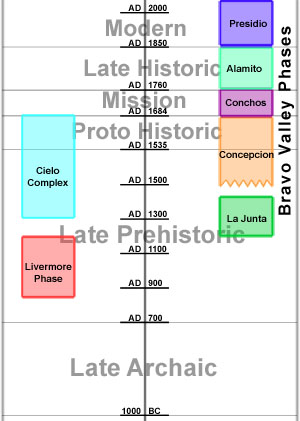
The known cultural chronology of the La Junta region as used by archeologists today for the last three thousand years. The major periods shown in gray are fairly standard terms used by most archeologists in Texas. The brightly colored blocks represent cultural patterns that have been defined for the eastern Trans Pecos region (on the left) and for the La Junta district ("Bravo Valley Phases" on the right).
Kelley considered his Bravo Valley sequence to be merely a "working framework." In 1990 he lamented the fact that this framework "unfortunately soon achieved the status of a dogma." Kelley recognized that these cultural patterns need to be refined and redefined (or scrapped altogether) based on new data and ideas. |
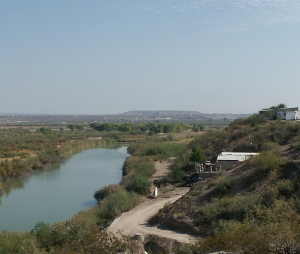
The landscape of confluence of the Rio Conchos and Rio Grande has abundant unmistakable evidence of flood deposits and erosion. In this scene the lower Conchos snakes its way to the confluence area, which is marked by the stand of cottonwood trees in the near background. To the left, the flat modern floodplain on the north side of the Conchos conceals numerous abandoned meander scars of the river. The dirt road in the foreground on the other side of the river cuts through fine silty alluvium deposits that flanks the high gravel terrace upon which Ojinaga sits. Deep excavations across this scene would undoubtedly encounter archeological deposits from many different periods, probably stretching back thousands of years. Photo by Steve Black.  |
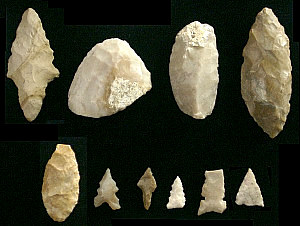
Chipped stone artifacts from Polvo that were collected from the surface by J. Charles Kelley in 1948. In the upper left is a Jora dart point-a poorly defined type originally identified in northern Mexico which dates to the Middle Archaic-one of the rare finds of relatively early artifacts in the La Junta district. The other items in the top row from left to right are two scrapers and a bifacial knife. The bottom row from left to right consists of a small thin biface probably representing an arrow point preform and various arrow points: Toyah, Perdiz, triangular, Harrell, and the tip of a stemmed arrow point. TARL Collections.  |
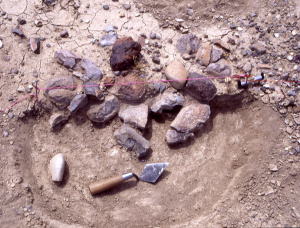
Late Archaic hearth feature radiocarbon dated to 160 B.C. to A.D. 60 excavated at the Running Toad site (41BS1493) near Lajitas, Texas. Photo by Andy Cloud, CBBS.  |
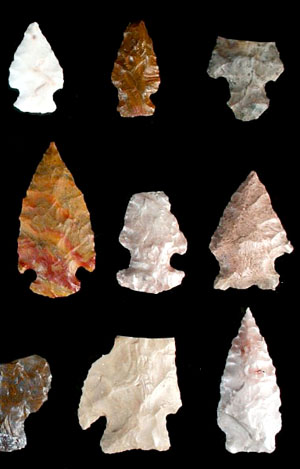
Late Archaic dart points from the Lone Dune site (41BS758) at Big Bend National Park show considerable stylistic range and material variation as well. Similar dart points are commonly found on high ground in the Rio Grande valley overlooking the La Junta village sites. There is no doubt that the floodplains of the river conceal Archaic deposits of various ages. Photo by Bobby Gray, CBBS. Enlarge to see all specimens.  |
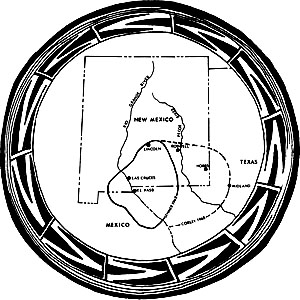
This map shows the core area of the Jornada Mogollon as defined by archeologist Donald J. Lehmer in 1948. The dashed line shows the area sometimes known as the "Eastern Jornada" where other Mogollon-related pithouse villages and small pueblos are found that share many similarities with the La Junta villages. The map's decorative border is adapted from an El Paso Polychrome bowl rim design. Courtesy of Pat Beckett.  |
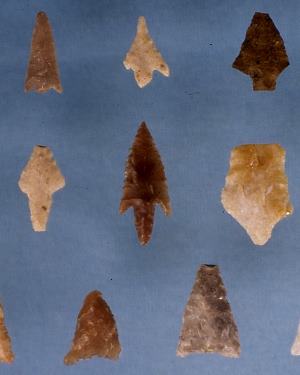
Perdiz and triangular arrow points from the surface of the Millington site. These styles of Late Prehistoric artifacts occur very widely across the eastern Trans-Pecos and far beyond and are associated with many different archeological cultures. Photo by Andy Cloud, CBBS.  |
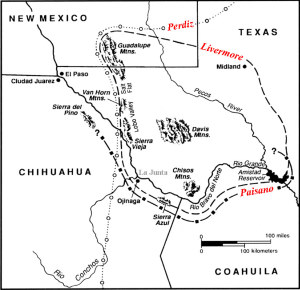
Distribution patterns of the successively later transitional Late Archaic Paisano dart points, Livermore arrow points, and Perdiz arrow points largely overlap in the eastern Trans-Pecos. The patterns seem to reflect at least some degree of shared cultural traditions from Late Archaic to Livermore phase to Cielo complex and the La Junta phase. Adapted from Mallouf 1999.  |
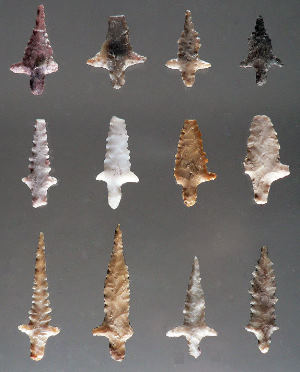
Livermore points are the hallmark of the Livermore phase. These examples are from the Livermore Cache, an extraordinary ritual deposit of artifacts found atop Mount Livermore in the Davis Mountains. Photo by Robert Mallouf, CBBS.  |
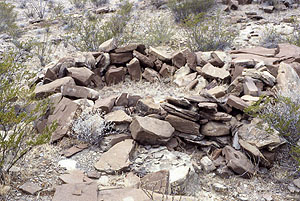
Cielo complex stacked-stone foundation of a circular wickiup: a brush-framed hut roofed with grass thatch or hides that could be built quickly. This example is from the Cerro Alto site in northeastern Chihuahua, west of the Rio Conchos. Photo by Robert Mallouf, THC Archives.
 |
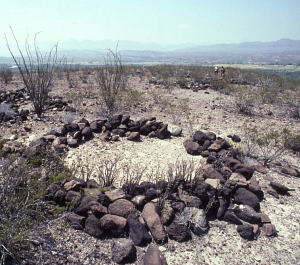
The Cielo complex site known as Arroyo de las Burras is situated on a mountain pediment overlooking the Rio Grande near Redford. In the foreground is the stacked-rock outline of a typical Cielo complex wickiup. In the background is the Rio Grande valley. Photo by Robert Mallouf.  |
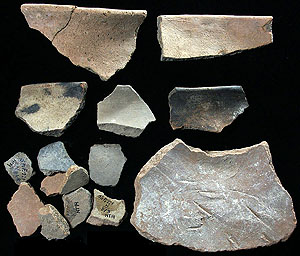
Chinati Plain sherds from Millington, as classified by Kelley and assigned to the Concepcíon phase (focus). TARL Collections.  |
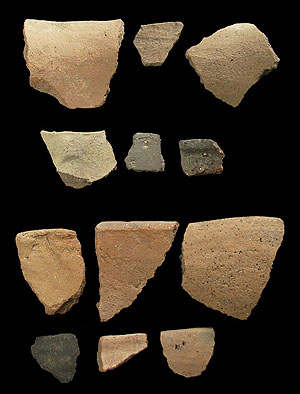
Capote Plain rim sherds from Millington, as classified by Kelley and assigned to the Concepcíon phase (focus). TARL Collections.  |
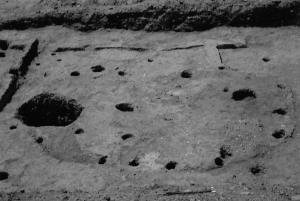
Superimposed structures at the Millington site, illustrating how the architectural sequence through time is determined. In this case, the small circular structure probably dating to the Concepcíon phase overlies the small pueblo dating to the La Junta phase. CBBS Archives, Sul Ross.  |
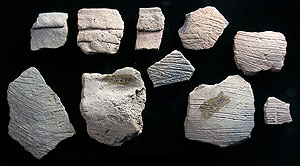
Chinati Scored sherds from Millington, as classified by Kelley and assigned to the Concepcíon phase (focus). The second sherd from the left on the top row appears to be from a corrugated vessel. TARL Collections.  |
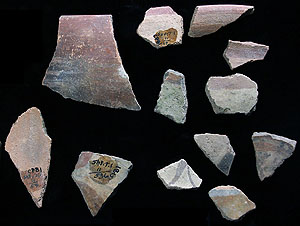
Capote Red-on-brown pottery from Millington, as classified by Kelley and assigned to the Concepcíon phase (focus). TARL Collections.  |
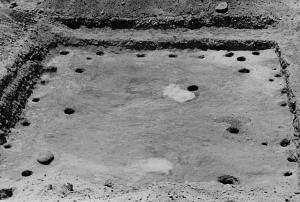
Rectangular house dating to the Concepcíon phase. Structure 18 at the Millington site. CBBS Archives, Sul Ross.  |
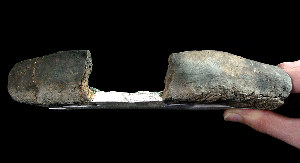
This Conchos Plain "platter" recovered by Kelley from Loma Alta appears to be a "comal" or ceramic griddle used to make tortillas. This food-preparation technique was probably introduced to La Junta by native peoples from central Mexico or perhaps by the Spanish. TARL Collections.  |
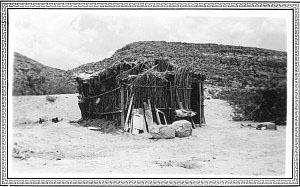
"Alamito Focus. Mexican Paling House of ocatilla [sic]. Boquillas, Texas in Lower Big Bend, 1936." reads the typed caption on this photograph by J. Charles Kelley. The use of ocotillo in house construction in the La Junta vicinity (and more generally the Big Bend and northern Mexico) illustrates the long-lived continuity of certain patterns established by the La Junta phase villagers some 700 years earlier. Kelley used the term "Alamito Focus" to designate the local Mexican culture during modern historic era (after 1850) in the Bravo Valley cultural sequence. CBBS Archives, Sul Ross.  |
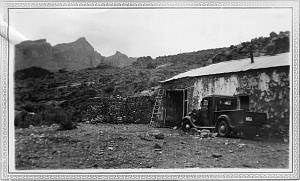
"Presidio Focus. Mexican ranch house of stone. Now used as cow camp headquarters for American ranch. Abandoned from spring failure. Lower Chisos Mts. 1937" reads the typed caption on this photograph by J. Charles Kelley. The stone structure behind the truck appears to have had a white-washed adobe plaster. Kelley's "Presidio Focus" designated the local Anglo culture that began to develop in the Big Bend area in the mid-19th century. CBBS Archives, Sul Ross.  |
|



















